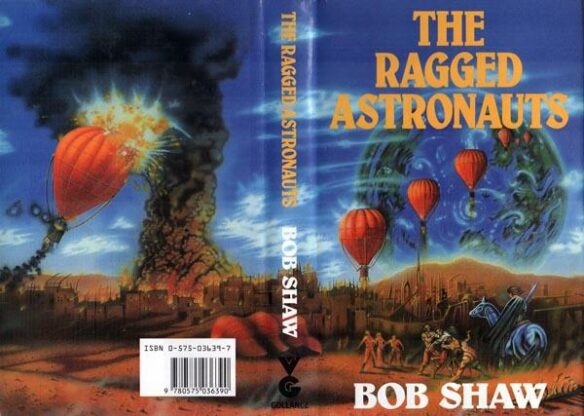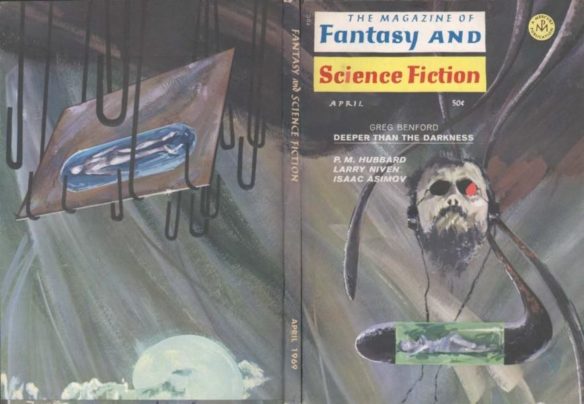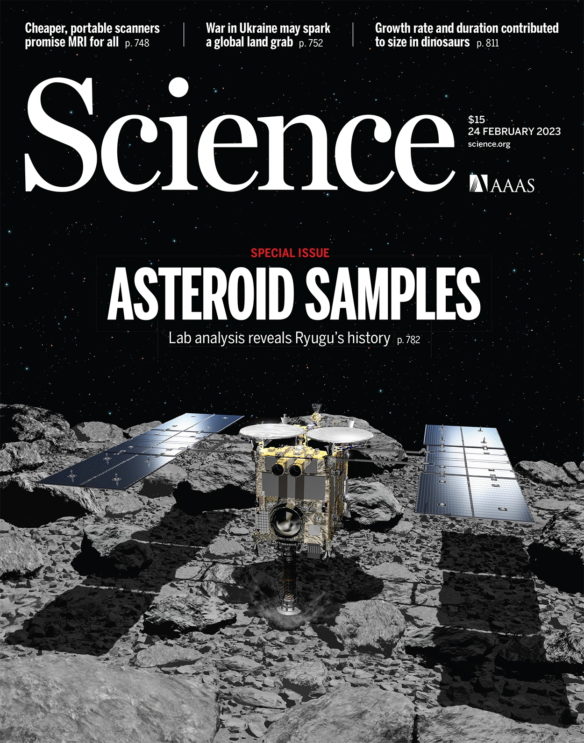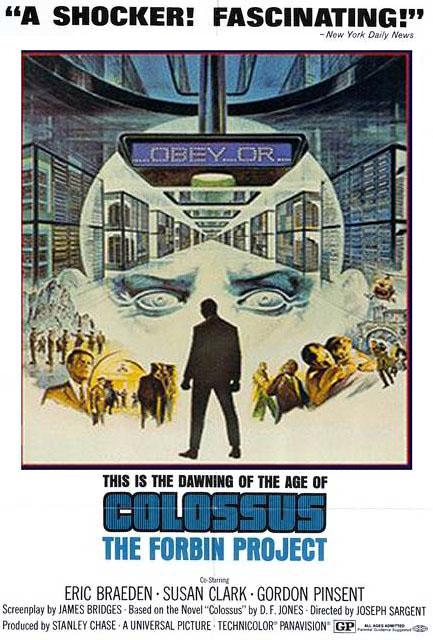(1) A GREEN THUMB – AND SO IS EVERYTHING ELSE. G. W. Thomas brings us clippings from “Plant Monsters of the 1950s” at Dark Worlds Quarterly.
If you missed the 1940s…
With the Plant Monsters of the 1950s we see the last of the Pulps and the transition to digest-sized SF. We also get the biggest plant monster hit since the days of H. G. Wells. John Wyndham, a Pulp writer, now rebranded a novelist, gave us The Day of the Triffids (1951). This book proved many things besides that Wyndham was fun to read. It proved that plant monsters could be a bestseller. It proved old SF ideas could be re-modeled for new purposes. And it proved that the 1950s was going to be an exciting time for plant stories.
The first example Thomas comes up with is —
“Flowering Evil” by Margaret St. Clair (Planet Stories, Summer 1950) is an unusual tale since Planet Stories’ policy was that their tales take place off planet. St. Clair’s story has a woman back on Earth who has a fantastic menagerie of plants from other planets. One in particular looks like a giant spider, ready to pounce. This is the Venusian Rambler that finally tries to devour Aunt Amy. She takes him out with a bar of soap!
(2) FROM BARBIE TO NARNIA? “Greta Gerwig Says She’s ‘Properly Scared’ To Tackle Netflix ‘Narnia’ Films, Addresses Prospect Of Directing A ‘Bond’ Pic” at Deadline.
…While there have been whispers about Gerwig tackling Narnia for some time, the reality of it solidified in a recent profile of Gerwig and Barbie toymaker Mattel in The New Yorker. News of a Narnia project from Netflix had been awaited for some time, given the streamer’s inking of a multi-year deal for rights to the books back in 2018. The fantasy books tell the story of siblings coming of age during WWII who escape via a wardrobe to a magical realm known as Narnia, where they play a key role in fending off the advances of evil, and were previously adapted into three films from Disney and Fox, which collectively grossed over $1.58B worldwide.
Gerwig’s highly buzzy summer feature Barbie has Margot Robbie playing the iconic doll, with Ryan Gosling as her partner Ken, watching as the pair face an existential crisis when they leave the utopian Barbie Land for the real world. The Warner Bros pic has scored the best preview box office of the year to date, as we told you first, at a total of $22.3M.
(3) VAL LEWTON APPRAISED. Bill Ryan reminds readers there was an artist at work in these little-regarded horror movies: “Death is Good: The Horror Films of Val Lewton” on the Roger Ebert website.
…I first heard about Lewton through Harlan Ellison’s Watching, a collection of the short story writer’s film criticism. In one essay, he describes at length the most suspenseful and beautifully constructed sequence in “The Leopard Man” (1943). Directed by Jacques Tourneur and adapted by Ardel Wray and Edward Dein from the novel Black Alibi by the great pulp writer Cornell Woolrich, the sequence in question features a young girl in a New Mexico town making her way home at night after running an errand for her mother to buy a bag of flour. On the way home, what appears to be a leopard begins stalking her. The scene culminates with a moment of such exquisitely composed horror that Ellison wrote that in The Big Hiring Hall in the Sky that Lewton would definitely be rewarded with a “happy eternity” in an “alabaster palace.”…
…Making horror films was not Lewton’s ambition, it was simply the assignment given to him by RKO Pictures. (He would parlay his success with the job into producing movies closer to his heart, like “Youth Runs Wild” and “Mademoiselle Fifi”). In fact, this bit of his career was loosely dramatized in Vincente Minelli’s “The Bad and the Beautiful,” when we see Kirk Douglas’ producer character Jonathan Shields struggling to make a quality picture out of the pulp horror title, “Doom of the Cat Men,” given to him by the studio. This also happened to Lewton, who was given titles—not actual scripts, mind you—like “Cat People” and told to make those titles into feature films. In “The Bad and the Beautiful” we see Shields and his director (Barry Sullivan) finding art in this cheap job they’d previously not cared about (it’s worth noting that, at least in my opinion, “Doom of the Cat Men” sounds like a much better film than any of the ones Shields is actually passionate about)….
(4) CRANK OUT THOSE WIDGETS. The New York Times explores “How TV Writing Became a Dead-End Job”.
For the six years he worked on “The Mentalist,” beginning in 2009, Jordan Harper’s job was far more than a writing gig. He and his colleagues in the writers’ room of the weekly CBS drama were heavily involved in production. They weighed in on costumes and props, lingered on the set, provided feedback to actors and directors. The job lasted most of a year.
But by 2018, when he worked on “Hightown,” a drama for Starz, the business of television writing had changed substantially. The writers spent about 20 weeks cranking out scripts, at which point most of their contracts ended, leaving many to scramble for additional work. The job of overseeing the filming and editing fell largely to the showrunner, the writer-producer in charge of a series.
“On a show like ‘The Mentalist,’ we’d all go to set,” Mr. Harper said. “Now the other writers are cut free. Only the showrunner and possibly one other writer are kept on board.”
The separation between writing and production, increasingly common in the streaming era, is one issue at the heart of the strike begun in May by roughly 11,500 Hollywood writers. They say the new approach requires more frequent job changes, making their work less steady, and has lowered writers’ earnings. Mr. Harper estimated that his income was less than half what it was seven years ago.
While their union, the Writers Guild of America, has sought guarantees that each show will employ a minimum number of writers through the production process, the major studios have said such proposals are “incompatible with the creative nature of our industry.” The Alliance of Motion Picture and Television Producers, which bargains on behalf of Hollywood studios, declined to comment further….
(5) SDCC DAY ONE. SYFY Wire has a gallery of cosplay photos from San Diego Comic-Con in “SDCC 2023: Cosplay From Day 1”. Amazing stuff!
(6) SFF SMALL ARMS. ScreenRant admires “10 Hilariously Unconventional Sci-Fi Weapons (That Were Surprisingly Effective)”.
Science fiction media prides itself on its innovative ideas, and nowhere is this more evident than in the creative weapons many favorite characters wield. From the iconic lightsabers from Star Wars to Thor: Love and Thunder’s new and improved Mjölnir hammer, there have been no shortage of unusual armaments in sci-fi history….
For example:
POV Gun, Hitchhiker’s Guide To The Galaxy
The Hitchhiker’s Guide To The Galaxy is absolutely full of outlandish and hilarious technology, like cows that cook themselves, or the ingeniously unique Point of View gun. Appearing only in the 2005 Hitchhiker’s Guide film instead of the books, the POV gun makes whoever is shot by it see things from the perspective of the wielder.
Hilariously, the gun was originally designed in the film to make men finally understand how their wives felt about things. Throughout the movie, the gun is used as a plot device to help the leads understand each other. However, at the end, it is comically weaponized by the famously nihilistic android Marvin to incapacitate a group of Vogons by making them see his worldview.
(7) MEMORY LANE.
1986 – [Written by Cat Eldridge from a choice by Mike Glyer.]
Bob Shaw is the writer of our Beginning this Scroll. Shaw was deep within our community to the extent that he won back to back Best Fan Writer Hugos at Seacon ‘79 and Noreascon Two. And as y’all know, he attended Worldcons as often as he could.
My favorite work by him is the Orbitsville trilogy set on a Dyson sphere. I like his short fiction but most critics think it pales in comparison to his novels but given that those critics aren’t generally authors, I’d say we can ignore their comments on this matter, don’t you think? Dark Night in Toyland was his last collection and it’s quite splendid indeed. So there.
We have as our Beginning, The Ragged Astronauts, the first novel of The Land and Overland trilogy. (And yes, it too is a splendid read.) It was published by Gollancz thirty-seven years ago. The cover illustration is by Alan Brooks.
It would garner a British Science Fiction Award and would be nominated for a Hugo at Conspiracy ’87 as well as an Arthur C. Clarke Award.
Should you be interested in reading it, it is a Meredith Moment at the usual suspects right now as are the two other novels in the trilogy, all at three dollars.
And here it is…
It had become obvious to Toller Maraquine and some others watching on the ground that the airship was heading into danger, but–incredibly–its captain appeared not to notice.
‘What does the fool think he’s doing?’ Toller said, speaking aloud although there was nobody within earshot.
He shaded his eyes from the sun to harden his perception of what was happening. The background was a familiar one to anybody who lived in those longitudes of Land–flawless indigo sea, a sky of pale blue feathered with white, and the misty vastness of the sister world, Overland, hanging motionless near the zenith, its disk crossed again and again by swathes of cloud. In spite of the foreday glare a number of stars were visible, including the nine brightest which made up the constellation of the Tree.
Against that backdrop the airship was drifting in on a light sea breeze, the commander conserving power crystals. The vessel was heading directly towards the shore, its blue-and-grey envelope foreshortened to a circle, a tiny visual echo of Overland. It was making steady isprogress, but what its captain had apparently failed to appreciate was that the onshore breeze in which he was travelling was very shallow, with a depth of not more than three hundred feet. Above it and moving in the opposite direction was a westerly wind streaming down from the Haffanger Plateau.
Toller could trace the flow and counter flow of air with precision because the columns of vapour from the pikon reduction pans along the shore were drifting inland only a short distance before rising and being wafted back out to sea. Among those man-made bands of mist were ribbons of cloud from the roof of the plateau–therein lay the danger to the airship
Toller took from his pocket the stubby telescope he had carried since childhood and used it to scan the cloud layers. As he had half expected, he was able within seconds to pick out several blurry specks of blue and magenta suspended in the matrix of white vapour. A casual observer might have failed to notice them at all, or have dismissed the vague motes as an optical effect, but Toller’s sense of alarm grew more intense. The fact that he had been able to spot some ptertha so quickly meant that the entire cloud must be heavily seeded with them, invisibly bearing hundreds of the creatures towards the airship.

(8) TODAY’S BIRTHDAYS.
[Compiled by Cat Eldridge.]
- Born July 22, 1881 — Margery Williams. The Velveteen Rabbit (or How Toys Become Real) is the work that is by far her best-known work. Is it genre? Sure. And it has been adapted as video, audio and theatre myriad times. One audio version was narrated by Meryl Streep with music by George Winston. (Died 1944.)
- Born July 22, 1932 — Tom Robbins, 91. Author of such novels as Even Cowgirls Get the Blues and Another Roadside Attraction. ISFDB lists everything he’s done as genre and who am I to argue with them on this occasion at least? Well I will. Now Jitterbug Perfume, that’s definitely genre! Cowgirls Get the Blues got made into a rather excellent film by Gus Van Sant and stars Uma Thurman, Lorraine Bracco, and Keanu Reeves. Interesting note: Still Life with Woodpecker made the long list at one point for the Prometheus Award for Best Libertarian SF Novel.
- Born July 22, 1941 — Vaughn Bodé. Winner of Best Fan Artist Hugo at St. Louiscon. (He was nominated for Best Professional Artist as well but that honor went to Jack Gaughan.) He has been credited as an influence on Bakshi’s Wizards and Lord of the Rings. Currently there at least three collections of his artwork, Deadbone Erotica, Cheech Wizard and Cheech Wizard‘s Book of Me in print. (Died 1975.)
- Born July 22, 1941 — George Clinton, 82. Founder and leader of the bands Parliament and Funkadelic, who incorporated science-fictional themes in his music throughout his career, perhaps most notably with his 1975 hit album, Mothership Connection, which was a huge influence on Afrofuturism. (Xtifr)
- Born July 22, 1961 — Rena Owen, 62. New Zealand native who appeared as Taun We in Attack of the Clones and Revenge of the Sith as Nee Alavar. She also has minor roles in A.I. Artificial Intelligence, The Crow: Wicked Prayer, The Iron Man and The Last Witch Hunter. She had a lead role in Siren, a series about merfolk that lasted for three seasons and thirty-six episodes. Set in the state of Washington, it was, no surprise, filmed in British Columbia.
- Born July 22, 1964 — Bonnie Langford, 59. She was a computer programmer from the 20th century who was a Companion of the Sixth and Seventh Doctors. She also appeared in the thirtieth anniversary special Dimensions in Time. If you’re really generous in defining genre, she was in Wombling Free as Felicity Kim Frogmorton. Other than that, Who was all she did for our end of the universe.
- Born July 22, 1972 — Colin Ferguson, 51. Best known for being Sheriff Jack Carter on Eureka. I miss that series. Did it win any Hugos? He’s also been in Are You Afraid of the Dark, The Hunger, The X-Files, The Outer Limits, the Eureka “Hide and Seek” webisodes (anyone seen these?) and The Vampire Diaries. Oh and let’s not forget his Maytag commercials.
(9) COMICS SECTION.
Tom Gauld is on the job.
(10) BAT-RARITIES. In “Holy Bat-Toys!”, Heritage Auctions previews offerings from The Ultimate Batman Collection Signature® Auction on August 4-5.
…And one of the modern centerpieces – Hot Toys’ one-of-a-kind 2016 1:6-scale Batcave diorama, with a Batmobile and four “strange costumes” lifted straight from the cover of Detective Comics No. 165 – replicates Adam West’s underground lair down to the Batcomputer, Anti-Crime Eye Checker and Batanalyst. And, of course, West’s Batman and Burt Ward’s Robin are standing alongside that sweet ride.
Holy prototype, indeed.
This diorama was first displayed at the Batman 100 Hot Toys exhibition in Tokyo in September 2016, coinciding with the release of the first Suicide Squad movie. Visitors to the show were overwhelmed, and with good reason: The diorama is 9 feet wide, 5 feet deep and 4 feet tall – room enough to display all the custom-made pieces, including the Batmobile that first roared into the San Diego Comic-Con four years earlier. Hot Toys planned to roll out the iconic vehicle soon thereafter, but this remains the only one….
(11) ALMOST LIKE NEON. “Saturn’s Rings Shine in Webb’s Observations of Ringed Planet” at NASA.gov.
…On June 25, 2023, NASA’s James Webb Space Telescope turned to famed ringed world Saturn for its first near-infrared observations of the planet. The initial imagery from Webb’s NIRCam (Near-Infrared Camera) is already fascinating researchers.
Saturn itself appears extremely dark at this infrared wavelength observed by the telescope, as methane gas absorbs almost all of the sunlight falling on the atmosphere. However, the icy rings stay relatively bright, leading to the unusual appearance of Saturn in the Webb image….

(12) GOING PROSPECTING. “NASA Prepares for Launch to Golden Asteroid Worth $10 Quintillion” at SYFY Wire. Reminds me a little of Poul Anderson’s economic premise for Satan’s World, though it was a very different celestial body.
… NASA’s Psyche spacecraft, named for the asteroid it intends to visit, has spent the last year at the Astrotech Space Operations facility near NASA’s Kennedy Space Center. There, folks from the Jet Propulsion Laboratory (JPL) are working on final assembly and testing in advance of a planned October 5 launch. The spacecraft is headed for the asteroid 16 Psyche, roughly 279 kilometers (173 miles) across and orbiting inside the asteroid belt….
We’ve known that Psyche has existed for centuries, but only recently realized how valuable it might be, both in economic and scientific terms. Previous remote observations have suggested that Psyche might be the leftover core of a failed planet, from the construction phase of our solar system. Astronomers believe that because it appears to be comprised almost entirely of exposed metals like iron, nickel, and gold. If we could get our hands on such a massive piece of space, it would be worth more than the combined global economy, at an estimated $10 quintillion….
The spacecraft will be mounted to a SpaceX Falcon Heavy rocket, which will push it to its destination in the asteroid belt. In addition to scoping out one of our system’s treasure hoards, the mission will also serve as a testbed for technologies which could be used for crewed missions in the future. The launch itself will be the first interplanetary mission for the Falcon Heavy, laying the groundwork for future Mars missions. It will also carry an optical deep space communications system, part of NASA’s ongoing work to build an updated space communications network.
After getting into low-Earth orbit, Psyche will blast off toward the asteroid belt using solar electric propulsion. Six years later it will rendezvous with Psyche and set up camp for a 26-month mission. But this is only a prospecting mission. Psyche is going to look, not to touch….
(13) VIDEO OF THE DAY. At Media Death Cult, Moid has been continuing his ‘on location’ videos this time with a little rambling about “The Multiverse” in the History of Science Fiction.
[Thanks to John King Tarpinian, Chris Barkley, Michael Toman, Cat Eldridge, SF Concatenation’s Jonathan Cowie, Mike Kennedy, and Andrew Porter for some of these stories. Title credit belongs to File 770 contributing editor of the day Bonnie McDaniel.]





